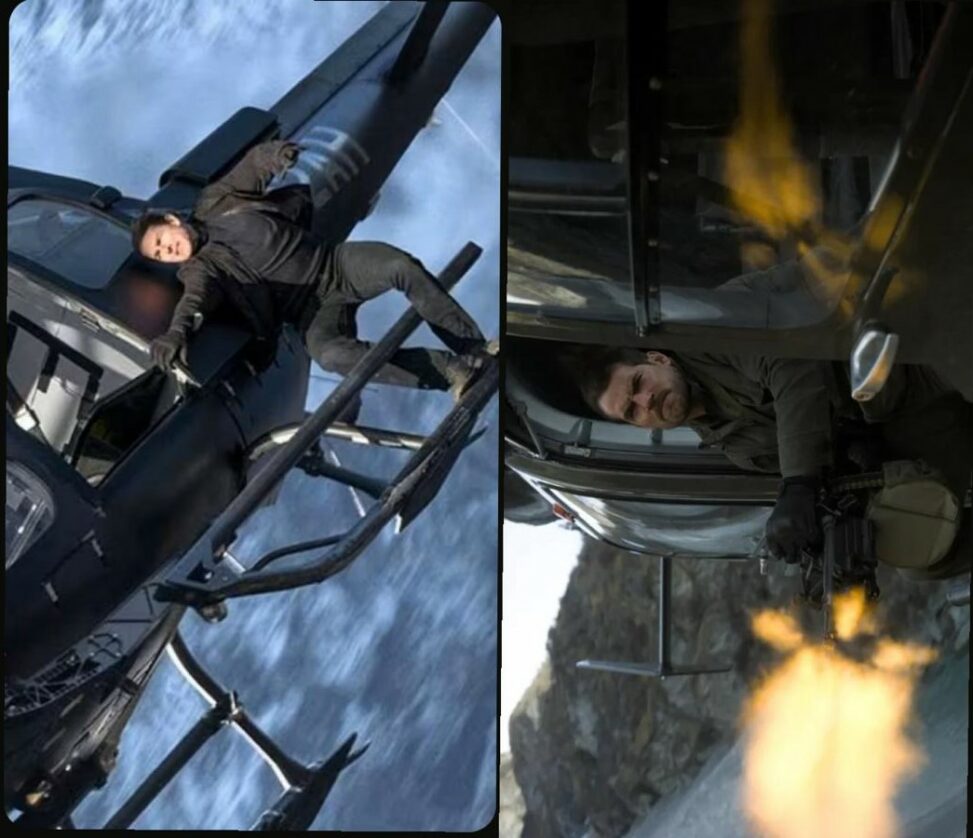In Mission: Impossible—Fallout’ (2018), which is directed by Christopher McQuarrie, is a cinematic display that pushes the limits of standard action filmmaking (The New York Times, 2018). I think that the film’s most amazing action is a helicopter pursuit that is expertly designed to provide unmatched thrills and excitement. The helicopter pursuit scene, which is framed by the imposing Kashmiri Himalayas, is a stunning display of both the wonders of nature and human innovation (Indiewire). The natural landscape and snow-capped peaks create an incredibly beautiful backdrop for the intense chase between Ethan Hunt and August Walker. The two individuals take viewers into a world of thrilling action and suspense as they cross the dangerous landscape.
The helicopter pursuit scene is a technical wonder of contemporary filmmaking. To guarantee that every aspect of the sequence was performed flawlessly, McQuarrie and his crew did not cut any corners (Andreawan, Hastuti, & Dewi, 2022). Modern camera gear and cutting-edge special effects technology made it possible to create breath-taking aerial shots and heart-pounding action scenes. The end product is a visually spectacular show that goes beyond what is possible for a screen.
The brilliant way that real-world effects and computer-generated imagery are blended together in the helicopter pursuit scene is one of its many brilliant elements. Although digital effects have transformed the film industry, McQuarrie chose to emphasise practical effects whenever feasible, giving the action a visceral and authentic feel (Andreawan, Hastuti, & Dewi, 2022). It is a wise choice to record a large number of the stunts in-camera rather than depending exclusively on computer-generated graphics, as this produces more dynamic and engaging action scenes that appeal to viewers’ basic senses.
In addition, the helicopter chase scene is evidence of the teamwork of the entire production crew. Every member of the crew is necessary to realising McQuarrie’s vision, from the expert stunt performers who risk life and limb to pull off jaw-dropping stunts to the give the visual effects artists who carefully improve and increase the film. The scene is a creative and collaborative accomplishment which shows the value of working together to achieve cinematic greatness.
The acting of lead actor Tom Cruise is crucial to the success of the helicopter scene. Cruise, who is known for his dedication to do his own stunts and accepted the task of flying a helicopter for a number of important sequences in the movie (The New York Times, 2018). Since viewers can see the actor’s ability and bravery up close, his commitment to authenticity and faith for the drama of the scene. The scene is made even more powerful by Cruise’s resolve to sacrifice all for the sake of his profession and set his place in Hollywood’s as a most recognisable action star cast.
The helicopter chase sequence thematically examines concepts such as willpower, selflessness, and the pursuit of justice. The main character, Ethan Hunt, must make difficult decisions and take risks in order to accomplish his ambitions. Moreover, this scenario demonstrates the evolution of action films. Action scenes used to be predictable, but directors like Paul McQuarrie are changing that. They are fusing clever storytelling and deeper ideas with impressive stunts. This puts more of an emphasis on the characters and plot of action films, making them more meaningful and engaging than simply enormous explosions.
Academic examination of the helicopter pursuit scene sheds light on its larger relevance in the context of modern action movie genre (Andreawan, Hastuti, & Dewi, 2022). Scholarly analyses focus on how the scene conveys themes of power, conflict, and resolution through mise en scene, cinematography, and editing techniques. Author have also underlined the sequence’s significance as a turning point in contemporary filmmaking by praising it for its narrative power, emotional relevance, and technical perfection. However, the box office performance of this movie did really well at the box office by bringing in over $791 million worldwide, according to Box Office Mojo. Also, the real-life consequences can be those who watch films such as “Mission: Impossible – Fallout” may experience real-life effects. Seeing a lot of violence in films can sometimes make it appear thrilling or acceptable. However, it’s crucial to consider if it’s appropriate to promote the violence for entertainment purposes. It is important for individuals to consider the messages these films give how they get convey and also could influence real-life behaviour.
In conclusion, ‘Mission: Impossible – Fallout’s’ helicopter pursuit scene is a cinematic masterwork that pushes the boundary of action moviemaking. The sequence fascinates audiences and creates a long- lasting impression with its breathtaking graphics, heart-pounding action, and conceptual complexity. Generations to come will be impacted by this famous scene’s significance as a pivotal point in modern cinema as we return and examine it.
References:
Andreawan, Ngakan Nyoman Bambang, Hilda Hastuti, & Puspita Dewi. (2022). An Analysis Illocutionary and Perlocutionary Found In “Mission: Impossible-Fallout. JISHUM : Journal Ilmu Sosial Dan Humaniora, 1(1), 83–96. https://doi.org/10.57248/jishum.v1i1.17
The New York Times. “Mission: Impossible – Fallout Review.” July 25, 2018. https://www.nytimes.com/2018/07/25/movies/mission-impossible-fallout-review-tom-cruise.html.
Indiewire. “Mission: Impossible — Fallout’: Staging That Crazy Helicopter Battle.” Accessed March 23,2024. https://www.indiewire.com/features/general/mission-impossible-fallout-how-they-staged-that-crazy-helicopter-battle-1201990416/.


Provide Feedback